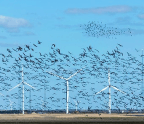An unclear future

I’m awakened by groups of revelers dancing through the cobblestone streets of Otavalo, a small town two hours north of Quito, Ecuador. Inti Raymi, the solstice festival of the sun, is hailed each year in late June with the pounding of drums, the invocation of pan pipes, and strumming of guitars, while twirling, singing celebrants costume themselves in colorful hats, masks, and the traditional woolen chaps that mountain cowboys have used for centuries here to ward off the Andean chill: zamarros — rough, malodorous leggings that form a thick white stripe down the outer thigh and calf.
‘We’ve never even found a nest. This bird is an enigma.’
In fact, Quito’s official bird takes its name from the zamarro. Just the day before, I had clambered around Jocotoco Foundation’s Reserva Yanacocha, looking for the Black-breasted Puffleg, Ecuador’s most endangered endemic hummingbird. Locals call the bird the zamarrito pechinegro, in honor of its “boots,” a noticeable tuft of white feathers just above its feet. Its only verifiable range is about 70 square kilometers near the parish of Nono, on the slopes of Pichincha, a volcano that towers over Quito.
Inti Raymi has been celebrated for centuries, its legacy withstanding attacks by the Catholic church and occasional apathy of Ecuadorians. It remains
You’re reading a preview, subscribe to read more.
Start your free 30 days



